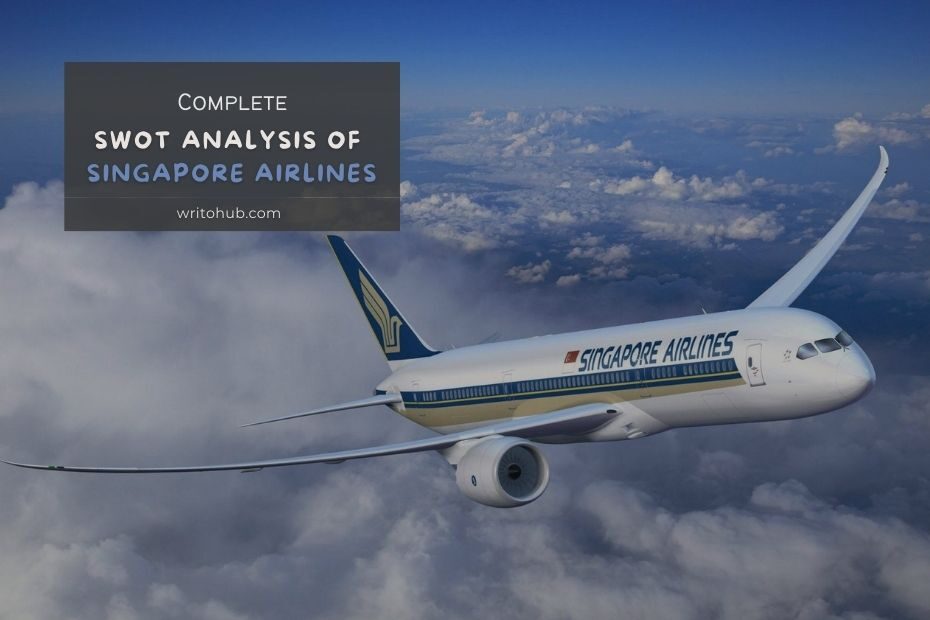The SWOT Analysis of Singapore Airlines tells the SWOT (Strengths, Weaknesses, Opportunities, and Threats) of the flag carrier of the Republic of Singapore – Singapore Airlines!
Singapore Airlines, a renowned flag carrier with a stellar reputation, operates in the competitive global aviation industry.
A SWOT analysis of Singapore Airlines reveals its strengths, weaknesses, opportunities, and threats, offering insights into its strategic positioning in the dynamic market.
Strengths in the SWOT Analysis of Singapore Airlines
- Strong Brand Image: Singapore Airlines is synonymous with luxury, quality service, and safety, contributing to its renowned global brand.
- Service Excellence: The airline is acclaimed for its exceptional in-flight services, including gourmet dining, entertainment, and attentive cabin crew.
- High Safety Standards: Singapore Airlines boasts an impeccable safety record, instilling confidence in passengers.
- Robust Fleet: The airline operates a modern and fuel-efficient fleet, reducing operating costs and environmental impact.
- Strategic Location: Singapore’s Changi Airport is a major global hub, providing the airline with a strategic advantage for connecting flights.
Weaknesses in the SWOT Analysis of Singapore Airlines
- Cost Structure: Operating as a full-service carrier, Singapore Airlines faces challenges in managing high operational costs, especially during economic downturns.
- Dependence on International Travel: The airline’s heavy reliance on international tourism and business travel makes it vulnerable to global economic fluctuations and travel restrictions.
- Intense Competition: Singapore Airlines faces fierce competition from other international carriers, as well as low-cost carriers on certain routes.
- Limited Domestic Market: Singapore’s small domestic market necessitates a focus on international routes, which can be volatile.
- Environmental Concerns: The airline faces growing scrutiny related to its environmental impact, particularly in terms of carbon emissions and sustainability.
Opportunities in the SWOT Analysis of Singapore Airlines
- Expansion in Emerging Markets: Exploring new routes and expanding operations in emerging markets can diversify revenue streams.
- Sustainability Initiatives: Investing in sustainable aviation practices and fuel-efficient aircraft can align with evolving environmental regulations and consumer preferences.
- Digital Transformation: Leveraging technology for e-commerce, customer engagement, and operational efficiency can enhance the passenger experience.
- Alliances and Partnerships: Strengthening partnerships with other airlines and joining global alliances can extend the airline’s reach and improve cost efficiencies.
- Cargo Operations: Growing the cargo business can offset revenue losses during passenger travel downturns, as witnessed during the COVID-19 pandemic.
Threats in the SWOT Analysis of Singapore Airlines
- Economic Downturns: Economic recessions can lead to reduced consumer and business travel spending, affecting the airline’s profitability.
- Global Health Crises: Pandemics and health crises, such as COVID-19, can severely disrupt international travel, leading to revenue losses.
- Competition from Low-Cost Carriers: The rise of low-cost carriers on regional routes can put pressure on ticket pricing and market share.
- Regulatory Changes: Evolving regulations related to aviation safety, environmental impact, and travel restrictions can impact operations and compliance costs.
- Geopolitical Factors: Political instability, trade tensions, and diplomatic issues can affect international routes and alliances.
Conclusion
Singapore Airlines’ SWOT analysis highlights its position as a premium carrier with a strong global presence.
To maintain and enhance its market presence, Singapore Airlines must leverage its strengths, address weaknesses, seize opportunities, and mitigate threats while adapting to changing market dynamics and consumer expectations.
Embracing sustainability, digitalization, and strategic expansion will be crucial in navigating the evolving aviation landscape.
